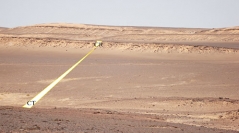

 Geodiversitas
33 (4) - Pages 553-580
Geodiversitas
33 (4) - Pages 553-580The lower Devonian (Upper Lochkovien to Emsian) rocks of the Saoura-Ougarta offers an example of mud-dominated platform with sandstone and limestone tempestites (Dkhissa Formation) bearing benthic fauna, and shales-sandstones beds with limestone episodes (Teferguenite Formation). The facies successions show retrogradational and progradational trends with an evolution from the offshore transition to shoreface (lower member) and from offshore transition to foreshore (upper member) with some carbonate intercalations with SCS structures and stromatolithic crusts. At the base of the Teferguenite Formation, the limestone episodes (A, B and C bars) reflect brutal change of the environmental conditions with sedimentation on carbonate ramp, in its mid position, interfingering with siliciclastics phases. They represent, in the Saoura-Ougarta, rapid transgressive episodes alternating with silicilastics phases in high marine level. The sedimentary dynamic is largely dominated by storms without any direct continental influence (fluvial) ruling out previous deltaic environnement interpretation in the lower Devonian of the Saoura-Ougarta. Our analysis shows that each limestone episode of the Dkhissa Formation corresponds to the tempestites while the limestone bars of the Teferguenite Formation may reflect eustatic variations. For the first time, we define tectono-eustatic T-R cycles (Ld1, Ld2, Ld3, Ld4 and Md1) which correlate with regional events on of the Saharan Western platform. Finally, when we integrate regional data, we remark that the transgressive episodes (bars A, B and C) of the Teferguenite formation, coincides with regional emersion in the Ahnet. Corresponding to what Elmi (1990) called “Haug effect” (“effet Haug”) for a same dynamic when the basin (here the Saoura) is in deepening regime and the plateform (north border of the Touarg shield) shows exondation (transect Ahnet-Bed el Mass and foum Belrem ridge).
Devonian, Saoura-Ougarta, tempestites, Dkhissa Formation, Teferguenite Formation, forced regression, cycles